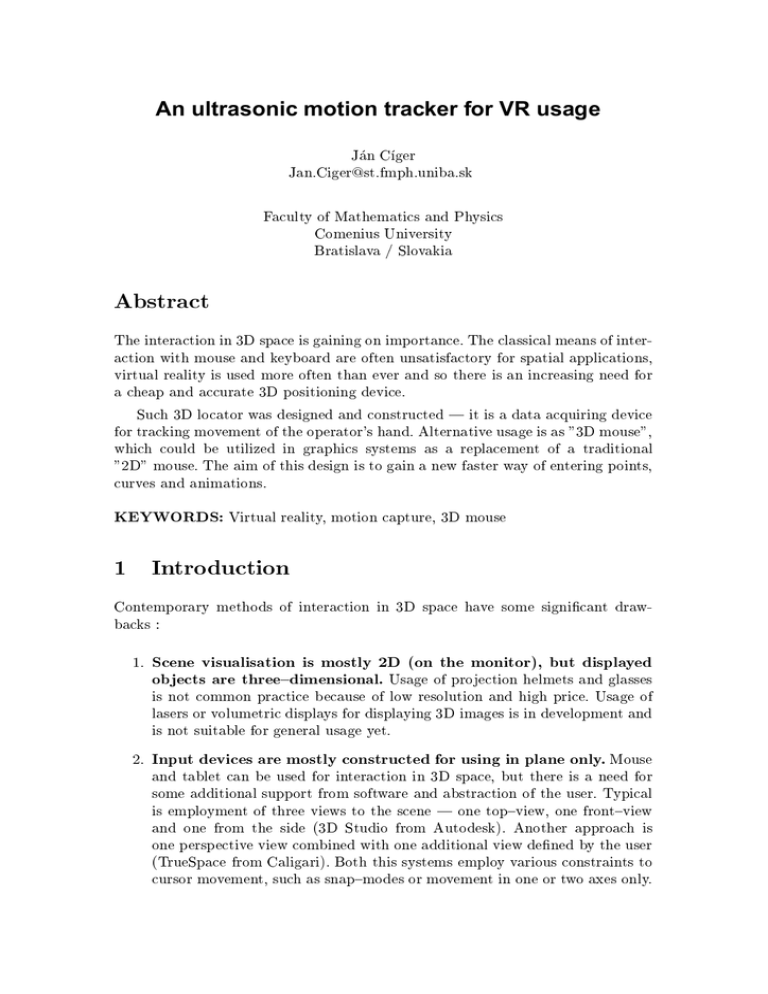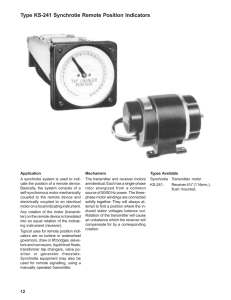An ultrasonic motion tracker for VR usage
advertisement

An ultrasonic motion tracker for VR usage
Jan Cger
Jan.Ciger@st.fmph.uniba.sk
Faculty of Mathematics and Physics
Comenius University
Bratislava / Slovakia
Abstract
The interaction in 3D space is gaining on importance. The classical means of interaction with mouse and keyboard are often unsatisfactory for spatial applications,
virtual reality is used more often than ever and so there is an increasing need for
a cheap and accurate 3D positioning device.
Such 3D locator was designed and constructed | it is a data acquiring device
for tracking movement of the operator's hand. Alternative usage is as "3D mouse",
which could be utilized in graphics systems as a replacement of a traditional
"2D" mouse. The aim of this design is to gain a new faster way of entering points,
curves and animations.
KEYWORDS:
Virtual reality, motion capture, 3D mouse
1 Introduction
Contemporary methods of interaction in 3D space have some signicant drawbacks :
1. Scene visualisation is mostly 2D (on the monitor), but displayed
objects are three{dimensional. Usage of projection helmets and glasses
is not common practice because of low resolution and high price. Usage of
lasers or volumetric displays for displaying 3D images is in development and
is not suitable for general usage yet.
2. Input devices are mostly constructed for using in plane only. Mouse
and tablet can be used for interaction in 3D space, but there is a need for
some additional support from software and abstraction of the user. Typical
is employment of three views to the scene | one top{view, one front{view
and one from the side (3D Studio from Autodesk). Another approach is
one perspective view combined with one additional view dened by the user
(TrueSpace from Caligari). Both this systems employ various constraints to
cursor movement, such as snap{modes or movement in one or two axes only.
These are needed to simplify the interaction with objects in the scene for the
user.
Some of the possible enhancements of the interaction methods :
1.1
For example \SpaceBall", joysticks
with spinning handles, force{feedback devices etc.
Enhancing existing input devices.
Using devices, which were constructed for 3D interaction from
start. Examples are data{gloves and 3D mice.
These are used mostly for animations and are
too expensive for the common use.
Motion{capture systems.
Types of 3D locators
1. Optical and opto{mechanical systems. Optical systems use markers,
which are placed on the moving object and tracked with cameras. They are
used mostly in motion{capture systems. Opto{mechanical systems employ
glass or plastic bers, acting as waveguides. When the ber is deformed, light
evades from it and this can be detected as change in the intensity of the light
on bre's end. Typical usage is in data{gloves and data{suits.
2. Mechanical systems. These use complicated system of arms and ankles
with several degrees of freedom. Each ankle has sensor for detecting angular
movement, some systems are equipped with force{feedback. They are accurate and relatively cheap, but rather unwieldy. They are used mostly in
robotics and simulators.
3. Locators employing acoustic waves. Usually work with ultrasonic signal,
idea is very simple |- they measure Time Of Flight (TOF) of the emitted
signal from transmitter to several receivers. Using at least three non{collinear
receivers enables calculation of the position in the working volume. This
principle was used in the design of the 3D mouse.
4. Magnetic trackers. Magnetic sensors are widely used because they are
cheap, but they have several disadvantages | low accuracy, sensitivity to
interference caused by large metallic objects and small range.
5. GPS based systems. These are used mostly in robotics and navigation,
have only limited usage in VR, because they don't work inside of buildings,
have low resolution (several meters) and are very expensive.
2 How does it work
In articles [3], [4] was published a simple method for position determination in 3D
space with possible robotic application. These works gave an inspiration and basic
knowledge about using ultrasonic waves for position sensing.
The idea of the 3D mouse is actually very simple. The basic elements of the 3D
mouse are at least three ultrasonic receivers (non{collinear) and one transmitter
as shown at g. 1.
c0
c1
c2
r2
x2,y2,z2
x,y,z
x1,y1,z1
r1
Transmitter
r0
x0,y0,z0
Receivers
Figure 1: Working arrangement
The position in 3D space is calculated as follows :
1. Burst of the ultrasonic signal is emitted from the transmitter and \stop{
watch" is started.
2. After arrival of the ultrasonic wave to the receiver, \stop{watch" is stopped
and calculations start.
3. From the measured time and known velocity of the sound in the air (cca
340 m:s 1 ), distance to the each receiver is calculated. We use a simple
formula (1).
ri
= ti :v
(1)
is the calculated distance to the i-th receiver, ti is the measured time
(TOF) and v is the velocity of the sound in the air.
ri
4. Position in space is calculated from already known distances by solving equation system (2).
)2 + (y
2
x1 ) + (y
2
x2 ) + (y
(x
(x
(x
x0
)2 + (z
2
y1 ) + (z
2
y2 ) + (z
y0
)2 = r02
2
2
z1 ) = r1
2
2
z2 ) = r2
z0
(2)
are known coordinates of receivers, ri is the calculated distance from
transmitter to the corresponding receiver and nally x; y; z are coordinates
determining position of the transmitter in 3D space. System (2) can actually
have two solutions, but one of them can be safely ignored, because it describes
a point behind the receivers plane.
xi ; yi ; zi
3 Construction
The 3D locator consists from these parts :
Moving handle with ultrasonic transmitter
Interface to the computer (PC)
Plane with four receivers (three of them are suÆcient, the fourth is for maintaining some redundancy and improving accuracy).
All these parts are shown on the g. 2.
Ultrasonic
receivers
Multiplexor
Amplifier
Amplifier
Interrupt
Micro - controller
Input select.
Amplifier
RS-232
Amplifier
Ultrasonic transmitter
Figure 2: Schematic diagram
As ultrasonic receivers and transmitter are used crystal units with resonance
frequency at cca 40 kH z . Each receiver has its own amplier with amplication
ratio 900 : 1. These receivers are multiplexed into one signal, which drives interrupt
line of the micro{controller. Not shown, but important parts are driver and receiver
of RS{232 line and power supply.
Micro{controller used is an 8{bit type AT89C2051 from Atmel. It contains
128B RAM, 2kB Flash EPROM, 2 counters/timers, serial interface and analog
comparator. Usage of this progressive part simplied construction a lot, because
all the hard work is done inside the micro{controller. It has these main tasks :
Generates 40 kH z signal for the transmitter
One of the timers acts as an accurate \stop{watch"
Does rst pre{ltering of measured data
Communicates with controlling PC via RS{232 interface (serial line)
Construction was inspired by article [7], where is described an ultrasonic motion
detector for security applications. The digital part of the construction is an original
work.
The simplied algorithm of the micro{controller can be described as follows :
1. After power{up or reset, micro{controller is awaiting conguration data and
the starting command.
2. When starting command arrives, endless loop of measuring and sending data
begins.
3. TOF is measured for all four receivers.
4. Status of the two buttons on the handle is detected and saved.
5. Test is performed, if there was some movement compared to previous measurement. If no, data are discarded.
6. Data are pre{ltered, most of largest errors are ltered out.
7. Pre{processed data are sent to the host{computer via serial line.
8. Process repeats from point 3.
Achieved parameters can be summarized in the following table :
Parameter
Value
Degrees of freedom
Resolution
Working volume
Remark
3
cca 0:5
cca 40
mouse cannot determine pitch and roll
theoretically should be possible
cm
40 40
Max. working distance
cca 3
Max. angular error
cca 15Æ
m
to achieve even 1
cm
mm
typical (desktop) installation
in
z
axis, distance of the transmitter
from receivers plane
angle, by which it is
possible to receive signal
from the transmitter
Sampling frequency
cca 20
Hz
depends on
distance of the transmitter to receivers
Costs
cca 6000
Sk
Cost of the material and salary
of the one skilled person to build it
4 Software
3D mouse without good software would be only a dead piece of plastic, so several
programs were developed. All software was written for free Unix clone | Linux
and graphics was done with help of the Mesa library (free OpenGL clone). Software
consists of these programs :
Mouse \driver" | it's main task is communication with hardware. The term
driver is little inappropriate, because it is a user{space task, actually a separate thread of execution. Besides communication, it provides the application
with calculated and ltered coordinates of the moving transmitter.
Calibrator | it serves as a mean to standardize each installation of the 3D locator. It calculates normalization matrix, which is used to convert calculated
coordinates of the 3D mouse (transmitter) to the unied cube.
Simple metaballs modeller | this is a demonstration application, which
shows some capabilities of the 3D mouse. The modeller is actually very simple, allows limited count of spherical primitives only. Displaying of metaballs
is done by the \Marching Cubes" algorithm, which was adopted from [5]
and calculations needed were taken from [2] and [1]. User interface of the
modeller was inuenced mostly by [6], [8]. It is actually very simple and was
not designed with serious work in mind. It cannot even save the modelled
object into the le . . . Figures 3 and 4 show the modeller \in action".
Figure 3: Skeleton of metaball
Figure 4: Corresponding metaball
5 Conclusions
The choosed design was rather successful and surprisingly simple to build. But
there remain some problems to solve. The most important and most annoying are
ultrasonic echoes from near objects. They interfere with measuring of distance and
add noise to the measured data. Thus ltering has to be done, but this slows things
down a lot. There is an idea to move the ltering algorithm to micro{controller and
do it in hardware in some future version of the rmware, but this will need more
computational power than used type of micro{controller can provide. Another idea
is to add remaining three degrees of freedom (rotations), but this will require major
changes in construction.
Software part of the project needs some more work too. One of the most challenging ideas is integration with some well known modeller such as Caligari's
TrueSpace or Autodesk's 3D Studio. Some work on TrueSpace is already done,
but due to lack of time, progress is very slow.
This project can be an example, how can be VR technology used even with a
tight budget and simple equipment.
References
ara. Modern poctacova graka. Computer Press,
[1] B. Benes, P. Felkel, and J. Z
1998.
[2] P. Bourke. http://www.mhri.edu.au/~pdb/modelling/implicitsurf/. Introduction to metaballs.
[3] F. Figueroa and A. Mahajan. A robust method to determine the coordinates
of a wave source for 3d position sensing. ASME Journal of Dynamic Systems,
Measurements and Control, Vol 116, pp. 505 511, 1994.
[4] F. Figueroa and A. Mahajan. An automatic self installation and calibration
method for a 3d position sensing system using ultrasonics. ASME Journal of
Dynamic Systems, Measurements and Control, 1996.
[5] P. Heckbert. Graphics Gems IV. Academic Press, 1994.
[6] R. Herr and P. Slavk. Interaction in 3d space and 3d window manager. In
Selected Readings 1995 of the Computer Graphics Group, part II. Dept. of
Computer Science and Engineering, Czech Technical University Prague, 1995.
[7] P. Straznicky. Ultrazvukovy detektor pohybu. Prakticka Elektronika A Radio,
4:14,15, 1996.
[8] H. Wurnig. Design of a collaborative multi user desktop system for augmented
reality. In Proceedings of the CESCG '98, 1998.

